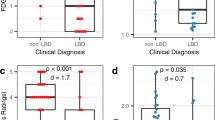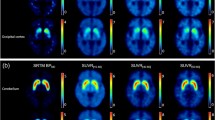Abstract
For therapeutic and prognostic reasons it is important to differentiate between idiopathic parkinsonian syndrome (IPS, Parkinson’s disease) and atypical parkinsonian syndromes (APS) like multiple system atrophy or progressive supranuclear palsy. Whereas IPS patients usually show a normal or upregulated postsynaptic dopamine D2 receptor profile, APS patients present decreased postsynaptic tracer binding. The aim of this prospective study was to evaluate the D2 receptor antagonist fluorine-18 desmethoxyfallypride (18F-DMFP), a recently developed positron emission tomography (PET) tracer with better clinical availability than carbon-11 raclopride, for the differential diagnosis of IPS versus APS. The study included 16 healthy control subjects and 35 patients with clinically diagnosed parkinsonism (16 IPS patients, 19 APS patients). All patients underwent PET imaging after injection of 180–200 MBq 18F-DMFP. Receiver operating characteristic (ROC) analyses were performed in order to assess the diagnostic performance of 18F-DMFP PET. We found the striatal 18F-DMFP uptake ratio to be significantly (P<0.01) reduced in the APS patients (2.44±0.42) compared with the healthy control subjects (3.61±0.43) and the IPS patients (3.21±0.78), whereas the uptake ratios of the IPS patients and the control subjects did not differ significantly. For the differential diagnosis of APS versus IPS, the ROC analysis of caudate 18F-DMFP binding showed a specificity, sensitivity and accuracy of 100%, 74% and 86%, respectively, as well as positive and negative predictive values of 100% and 76%, respectively. Based on these first clinical results, we consider 18F-DMFP to be an appropriate PET tracer for the differential diagnosis of parkinsonian syndromes, with the advantage of better clinical availability than 11C-labelled D2 radioligands.



Similar content being viewed by others
References
Sawle GV, Playford ED, Brooks DJ, Quinn N, Frackowiak RSJ. Asymmetrical pre-synaptic and post-synaptic changes in the striatal dopamine projections in dopa naïve parkinsonism. Brain 1993; 116:853–867.
Tatsch K, Schwarz J, Mozley PD, Linke R, Pogarell O, Oertel WH, Fieber RS, Hahn K, Kung HF. Relationship between clinical features of Parkinson’s disease and presynaptic dopamine transporter binding assessed with [123I]IPT and single-photon emission tomography. Eur J Nucl Med 1997; 24:415–421.
Brucke T, Djamshidian S, Bencsits G, Pirker W, Asenbaum S, Podreka I. SPECT and PET imaging of the dopaminergic system in Parkinson’s disease. J Neurol 2000; 247: Suppl 4:IV/2–7.
Booij J, Speelman JD, Horstink MW, Wolters EC. The clinical benefit of imaging striatal dopamine transporters with [123I]FP-CIT SPET in differentiating patients with presynaptic parkinsonism from those with other forms of parkinsonism. Eur J Nucl Med 2001; 28:266–272.
Quinn N. Multiple system atrophy. The nature of the beast. J Neurol Neurosurg Psychiatry 1989; 52 (Suppl):78–89.
Litvan I, Campbell G, Mangone CA, et al. Which clinical features differentiate progressive supranuclear palsy (Steele-Richardson-Olszewski syndrome) from related disorders? Brain 1997; 120:65–74.
Hughes AJ, Daniel SE, Kilford L, Lees AJ. Accuracy of clinical diagnosis of idiopathic Parkinson’s disease: a clinico-pathological study of 100 cases. J Neurol Neurosurg Psychiatry 1992; 55:181–184. Comment in: J Neurol Neurosurg Psychiatry 1993; 56:939.
Antonini A, Leenders KL, Vontobel P, Maguire RP, Missimer J, Psylla M, Günther I. Complementary PET studies of striatal neuronal function in the differential diagnosis between multiple system atrophy and Parkinson’s disease. Brain 1997; 120:2187–2195.
Brooks DJ, Ibanez V, Sawle GV, et al. Striatal D2 receptor status in patients with Parkinson’s disease, striatonigral degeneration, and progressive supraneclear palsy, measured measured with [11C]raclopride and positron emission tomography. Ann Neurol 1992; 31:184–192.
Kaasinen V, Ruottinen HM, Nagren K, Lehikoinen P, Oikonen V, Rinne J. Upregulation of putaminal dopamine D2 receptors in early Parkinson’s disease: a comparative PET study with [11C]raclopride and [11C]n-methylspiperone. J Nucl Med 2000; 41:65–70.
Schwarz J, Tatsch K, Arnold G, Gasser T, Trenkwalder C, Kirsch CM, Oertel WH.123I-iodobenzamide-SPECT predicts dopaminergic responsiveness in patients with de novo parkinsonism. Neurology 1992; 42:556–561 [erratum in: Neurology 1992; 42:1028].
Tatsch K, Schwarz J, Oertel WH, Kirsch CM. Idiopathic Parkinson syndrome: I-123 IBZM SPECT findings in drug naive and treated patients [abstract]. Eur J Nucl Med 1992; 19:609.
Gründer G, Siessmeier T, Piel M, Vernaleken I, Buchholz HG, Zhou Y, Hiemke C, Wong DF, Rösch F, Bartenstein P. Quantification of D2-like dopamine receptors in the human brain with18F-desmethoxyfallypride. J Nucl Med 2003; 44:109–116 [erratum in: J Nucl Med 2003; 44:145].
Gilman SL, Low PA, Quinn N, et al. Consensus statement on the diagnosis of multiple system atrophy. J Auton Nerv Syst 1998; 74:189–192.
Mukherjee J, Yang ZY, Brown T, et al. Potential anomalies of dopamine D-2 receptor: challenges for non-invasive imaging studies by positron emission tomography. Med Chem Res 1994; 5:174–192.
Mukherjee J, Yang ZY, Brown T, Roemer J, Cooper M.18F-desmethoxyfallypride: a fluorine-18 labeled radiotracer with properties similar to carbon-11 raclopride for PET imaging studies of dopamine D2 receptors. Life Sci 1996; 59:669–678.
Piel M, Schirrmacher R, Hamkens W, Schmitt U, Hiemke C, Gründer G, Rösch F. Improved precursor synthesis and18F-fluorination of [18F]desmethoxyfallypride. J Labelled Cpd Radiopharm 1999; 42 Suppl 1:381–383.
Swets JA. ROC analysis applied to the evaluation of medical imaging techniques. Invest Radiol 1979; 14:109–121.
Hanley J, McNeil BJ. The meaning and use of the area under a receiver operating characteristic (ROC) curve. Radiology 1982; 143:29–36.
Litvan I. Recent advances in atypical parkinsonian disorders Curr Opin Neurol 1999; 12:441–446.
Poewe W, Wenning G. The differential diagnosis of Parkinson’s disease. Eur J Neurol 2002; 9 Suppl 3:23–30.
Churchyard A, Donnan GA, Hughes A. Dopa resistance in multiple system atrophy: loss of postsynaptic D2 receptors. Ann Neurol 1993; 34:219–226.
Ghaemi M, Hilker R, Rudolf J, Sobesky J, Heiss WD. Differentiating multiple system atrophy from Parkinson’s disease: contribution of striatal and midbrain MRI volumetry and multi-tracer PET imaging. J Neurol Neurosurg Psychiatry 2002; 73:517–523.
Tissingh G, Booij J, Winogrodzka A, van Royen EA, Wolters EC. IBZM- and CIT-SPECT of the dopaminergic system in parkinsonism. J Neural Transm Suppl 1997; 50:31–37.
Kung HF, Pan S, Kung MP, Kasliwal R, Reilly J, Alavi A. In vitro and in vivo evaluation of [123I]IBZM: a potential CNS D-2 dopamine receptor imaging agent. J Nucl Med 1989; 30:88–92.
Kung HF, Alavi A, Chang W, et al. In vivo SPECT imaging of CNS D-2 dopamine receptors: initial studies with iodine-123-IBZM in humans. J Nucl Med 1990; 31:573–579.
Schwarz J, Tatsch K, Gasser T, Arnold G, Pogarell O, Kunig G, Oertel WH.123I-IBZM binding compared with long-term clinical follow-up in patients with de novo parkinsonism. Mov Disord 1998; 13:16–19.
Perlmutter JS, Stambuk MK, Markham J, Black KJ, McGee-Minnich L, Jankovic J, Moerlein SM. Decreased [18F]spiperone binding in putamen in idiopathic focal dystonia. J Neurosci 1997; 17:843–850.
Perlmutter J, Moerlein S, Huang D-R, Todd R. Non-steady-state measurement of in vivo radioligand binding with positron emission tomography: specificity analysis and comparison with in vitro binding. J Neurosci 1991; 11:1381–1389.
Mukherjee J, Luh KE, Yasillo N, et al. Dopamine D-2 receptors imaged by PET in Cebus apella using [18F]benzamide neuroleptic. Eur J Pharmacol 1990; 175:363–364 [published correction appears in Eur J Pharmacol 1990; 187:143].
Mukherjee J, Christian BT, Dunigan KA, Shi B, Narayanan TK, Satter M, Mantil J. Brain imaging of18F-fallypride in normal volunteers: blood analysis, distribution, test-retest studies, and preliminary assessment of sensitivity to aging effects on dopamine D-2/D-3 receptors. Synapse 2002; 46:170–188.
Sasaki T, Amano T, Hashimoto J, Itoh Y, Muramatsu K, Kubo A, Fukuuchi Y. SPECT imaging using [123I]beta-CIT and [123I]IBF in extrapyramidal diseases. No To Shinkei 2003; 55:57–64.
Acknowledgements
Part of this work was supported by the Deutsche Forschungsgemeinschaft (Grant Ba 1011/2–1). The authors wish to thank Dr. M. Piel, S. Höhnemann and S. Maus (Institute of Nuclear Chemistry, Johannes Gutenberg-University Mainz) for tracer synthesis.
Author information
Authors and Affiliations
Corresponding author
Rights and permissions
About this article
Cite this article
Schreckenberger, M., Hägele, S., Siessmeier, T. et al. The dopamine D2 receptor ligand 18F-desmethoxyfallypride: an appropriate fluorinated PET tracer for the differential diagnosis of parkinsonism. Eur J Nucl Med Mol Imaging 31, 1128–1135 (2004). https://doi.org/10.1007/s00259-004-1465-5
Received:
Accepted:
Published:
Issue Date:
DOI: https://doi.org/10.1007/s00259-004-1465-5




